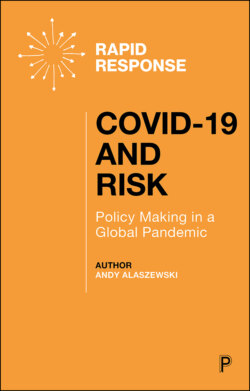Читать книгу COVID-19 and Risk - Alaszewski Andy - Страница 18
На сайте Литреса книга снята с продажи.
Framing COVID-19 as seasonal flu
ОглавлениеNot all countries in the western Pacific Rim immediately framed COVID-19 as SARS. Indeed, in China, patients in December 2019 presenting at the three main Wuhan hospitals with symptoms of COVID-19 were told they had flu or bronchitis (Honigsbaum, 2020, p. 262). When a whistleblower, Dr Li Wenliang, posted online on 30 December 2019 that there were ‘7 SARS cases confirmed’ at the seafood market, he was reprimanded by the local Security Office for ‘illegal rumour mongering’ and forced to sign a retraction (Honigsbaum, 2020, p. 262). Lockdown in Wuhan was delayed until 23 January 2020.
Similarly, in Japan the danger of COVID-19 was initially downplayed. This reflected its particular political circumstances: the Prime Minister, Shinzo Abe, was coming to the end of his time in office, and Japan was due to host the 2020 Olympics and wanted to avoid postponing them.
The ministry of health reported the first COVID-19 case on 15 January 2020, a Chinese national who had returned from Wuhan on 6 January and been hospitalised on 10 January (Japanese Times, 2020). At this stage, the public health message from the ministry was one of reassurance. The media coverage references SARS but the health ministry ‘issued a message to the public emphasising hand washing and other preventative measures similar to those taken for against a common cold or influenza’ (Japanese Times, 2020).
In both China and Japan, the framing of COVID shifted as the political elites accepted that COVID-19 was different to and more of a threat than seasonal flu. In Europe and most of the Americas, COVID was initially framed as seasonal flu and this framing was retained for longer and was more damaging.
Medical experts in Europe and North America were anticipating a pandemic and expected it to be some form of flu. This framing was reinforced by the early epidemiological evidence from China. Like flu, COVID-19 was highly contagious and older people and vulnerable people were more likely to have serious infections and die. Sally Davies, a former UK Chief Medical Officer, in her evidence to a joint inquiry by two UK Parliamentary Committees (Health and Science), reflected on the reasons why policy makers in the UK framed COVID-19 as flu not SARS. She noted that: ‘We were in groupthink… We did not – our infectious disease experts – really believe that another Sars would get to us, and I think it’s a form of British exceptionalism’ (Davies in Sample, 2020)
Davies observed that the UK had had two emergency pandemic planning exercises, Winter Willow in 2007 and Cygnus in 2018, and these identified shortcomings that were rectified, but both were based on the assumption that the pandemic would be some sort of flu. This meant that key elements of the response to a SARS-like disease were neglected. For example, Davies said that ‘When you’re planning for flu, the classic is you don’t bother to test, so we didn’t have a test-and-trace system to stand up’ (Davies in Sample, 2020). Since it is extremely difficult to prevent flu viruses spreading, the emphasis was on identifying the individuals who were vulnerable and advising these high-risk individuals to protect themselves. The virus could then spread through the rest of the healthy population and eventually die out as the population built up collective or ‘herd’ immunity.
There was another factor in the willingness to accept COVID-19 as a flu-like disease. It appealed to and served the interests of right-wing populist politicians such as the US President, Donald Trump, the UK Prime Minister, Boris Johnson and the Brazilian President, Jair Bolsonaro. These populist leaders had an interest in representing COVD-19 as flu-like so they could avoid unpopular actions such restricting social and economic activity.
